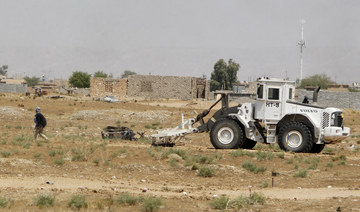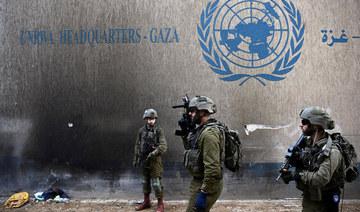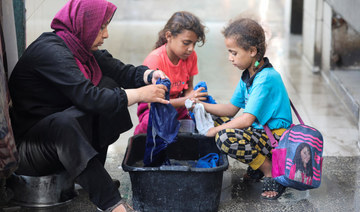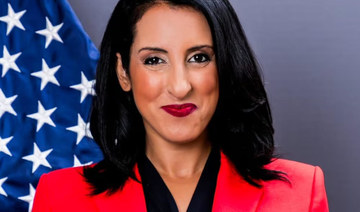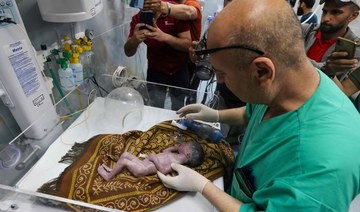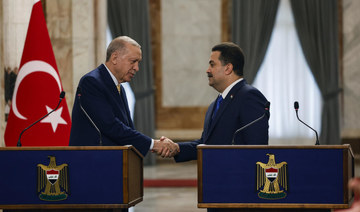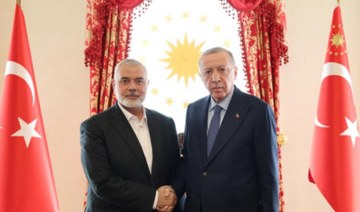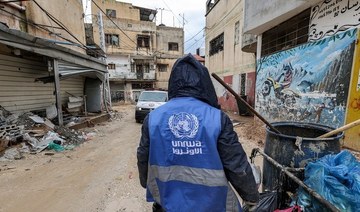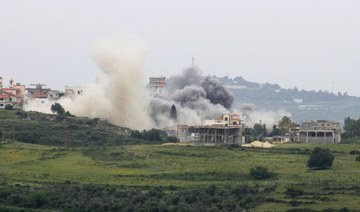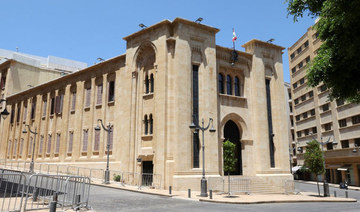RAQQA, Syria: The neighbors reported a foul smell coming from the house next door. The house, which the Daesh group had used as a school for its “cubs,” had been untouched ever since the militants were chased out of the Syrian city two years ago. Weeds grew around an abandoned car in its courtyard.
Even before the first responders felt the soft ground of the courtyard, they knew what was underneath: the latest mass grave in Raqqa, the former capital of the Daesh group’s self-declared “caliphate.”
On the first day of digging, they pulled out two bodies. Within a few days, that was up to nearly 20, including women and children, who had been stacked up in holes in the courtyard garden.
The discovery, seen by Associated Press journalists over the weekend, was the 16th mass grave found in Raqqa since Daesh militants were driven out in the summer of 2017. Even as Raqqa’s people gradually rebuild, the graves found in houses, parks, destroyed buildings are a grim reminder of the horrors perpetrated by the militants and the massive violence inflicted on the city to remove them.
During their rule, the extremists carried out mass killings, public beheadings and other atrocities. Women and men accused of adultery were stoned to death, while men believed to be gay were thrown from the tops of buildings and then pelted with stones.
More death came in the years-long aerial and ground campaign to liberate Raqqa, waged by Kurdish-led forces backed by airstrikes from the US-led coalition. The assault destroyed nearly 80% of Raqqa.
So far, 5,218 bodies have been exhumed from mass graves or from under the ruins of destroyed buildings around Raqqa, said Yasser Khamis, who leads the team of first responders. Of those, around 1,400 were Daesh fighters, distinguishable by their clothes and including some foreigners, he said. Of the remainder, 700 have been identified by their loved ones, mainly because they were the ones who buried the bodies.
Khamis said limited resources have slowed the search and made it difficult to determine the cause of death for most. But those killed have died in airstrikes, land mine explosions, mass killings or they were Daesh fighters or victims buried by the group. Some were recently exhumed with handcuffs.
The dead found in the latest grave were likely killed in the last days of the furious battles for Raqqa, buried in a rush during the fighting. The house is located in Raqqa’s Bedouin District, scene of one of the last Daesh stands against the siege.
The house was built in a traditional Arab style, with a courtyard in the center surrounded by rooms. The outside walls were pockmarked with bullet holes. Daesh had used it as a school during its rule, and school notebooks and children desks were strewn around the rooms.
In the garden in the courtyard, diggers pulled a new body from the ground Saturday as an AP team visited the site. It had a uniform on it, sign of an Daesh fighter. Digging ended Monday, with a total of 19 bodies found, including three women and two children.
Ibrahim Al-Mayel, a digger, said many of the bodies they had found had been piled roughly on top of each other in the ground.
Such house burials account for most of the city’s mass graves as civilians buried their dead where they could, unable to go far as fighting intensified. Other graves in the same district — two in homes, two in gardens — have yielded 90 bodies.
At least two mass graves have been found in open areas in the city — a public park and a training compound— or on the city’s edges, where fighters buried their own or people they killed. The grave in the park held at least 1,400 bodies, according to Khamis. His teams are still digging up bodies in a mass grave outside the city, where they found more than 700 so far.
“I expect that this Arab house is the last location within the city. We will then focus on the countryside,” Khamis said of the latest discovery.
Raqqa was the seat of the militant’s self-proclaimed caliphate, which at its height in 2014 stretched across a third of both Syria and Iraq. This year, the last village held by the group was retaken, in eastern Syria, though the militants are still present along the border and stage attacks.
In Syria’s 8-year-old civil war, more than 100,000 people have been detained, abducted or gone missing, according to the UN, most of them disappeared by the government. Tens of thousands have likely vanished into mass graves, many of them victims of IS. Khamis said his team has recorded 2,000 people missing from Raqqa, based on family reports. But he said the number doesn’t reflect the full reality, since many families gave up on their missing, couldn’t reach Khamis’ team or moved to other areas.
His team only began collecting samples from bodies three months ago, hoping that new training and DNA technology would be available to help identify them. That means only 1,600 bodies of the 5,200 found had samples taken from them before reburial. “We need a lot more,” he said.
In his offices in Raqqa, plastic bags carrying bone, teeth or hair samples were labelled and identified by location and number. International human rights groups say they are concerned local forensic groups are not getting the support, expertise and resources they need. Identifying the missing and preserving evidence for possible prosecutions is critical for Syria’s future, they say.
“The worst thing I saw in my life at these graves is a man who comes looking for his child and can’t find him,” said Hwaidi Munawakh, one of the gravediggers.
He has worked on nine of Raqqa’s mass graves. From one of them, he pulled out one of his cousins, a woman killed in an airstrike during the final battle for the city.
Syria’s Raqqa still finding the dead, 2 years after Daesh fall
Syria’s Raqqa still finding the dead, 2 years after Daesh fall
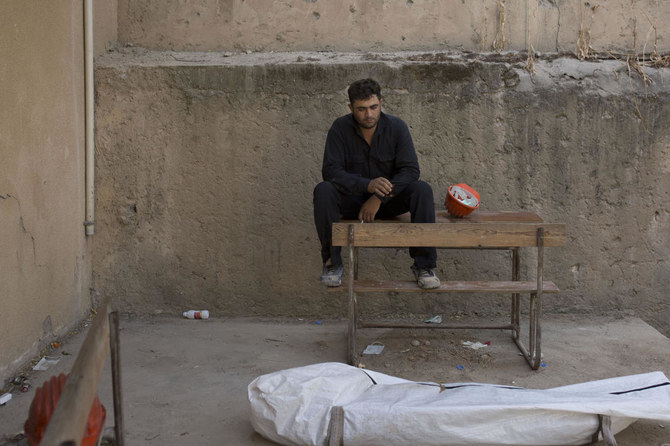
- The dead found in the latest grave were likely killed in the last days of the furious battles for Raqqa, buried in a rush during the fighting
- In Syria’s 8-year-old civil war, more than 100,000 people have been detained, abducted or gone missing, according to the UN, most of them disappeared by the government
1 case dismissed, 4 on hold in UN investigation into Oct. 7 allegations against UNRWA staff
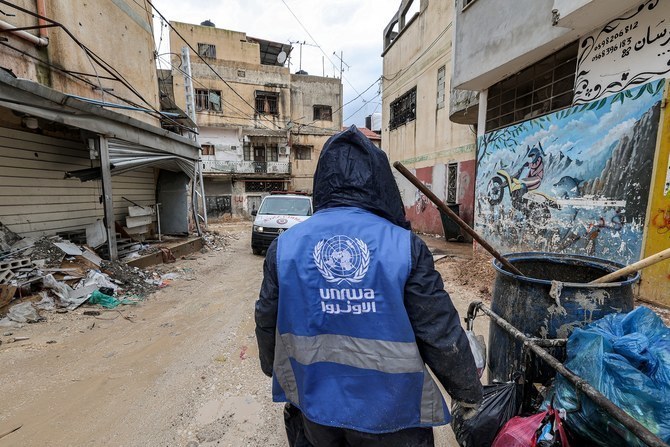
- Investigators have been looking into cases of 12 agency workers accused by Israel in January of participating in attacks by Hamas, and 7 others named later
- 14 cases remain under investigation but the others were dismissed or suspended due to lack of evidence; UN’s internal investigators due to visit Israel again in May
NEW YORK CITY: UN spokesperson Stephane Dujarric said on Friday that the organization’s internal oversight body has been investigating 19 employees of the UN Relief and Works Agency for Palestine Refugees over allegations that they were affiliated with Hamas and other militant groups.
Israeli authorities alleged in January that 12 UNRWA workers participated in the Oct. 7 attacks by Hamas against Israel.
The agency immediately cut ties with the named individuals, and UN Secretary-General Antonio Guterres, in consultation with UNRWA Commissioner General Philippe Lazzarini, ordered an independent review to evaluate the measures taken by the agency to ensure adherence to the principle of neutrality and how it responds to allegations of breaches of neutrality, particularly in the challenging context of the situation in Gaza.
In a wide-ranging report published this week, the investigators, led by Catherine Colonna, a former foreign minister of France, said Israeli authorities have yet to provide any evidence to support the allegations against UNRWA workers. They also noted that Israel had not previously raised concerns about any individuals named on the agency staffing lists it has been receiving since 2011.
They stated in the report: “In the absence of a political solution between Israel and the Palestinians, UNRWA remains pivotal in providing life-saving humanitarian aid and essential social services, particularly in health and education, to Palestinian refugees in Gaza, Jordan, Lebanon, Syria and the West Bank.
“As such, UNRWA is irreplaceable and indispensable to Palestinians’ human and economic development. In addition, many view UNRWA as a humanitarian lifeline.”
Guterres also ordered a separate investigation by the UN’s own Office of Internal Oversight Services to determine the accuracy of the Israeli allegations. The mandate of the OIOS, an independent office within the UN Secretariat, is to assist the secretary-general in the handling of UN resources and staff through the provision of internal audit, investigation, inspection and evaluation services.
Dujarric said the 19 members of UNRWA staff under investigation included the 12 named by the Israeli allegations in January, whose contracts were immediately terminated, and seven others the UN subsequently received information about, five in March and two in April.
Of the 12 employees identified by Israeli authorities in January, eight remain under OIOS investigation, Dujarric said. One case was dismissed for lack of evidence and corrective administrative action is being explored, he added, and three cases were suspended because “the information provided by Israel is not sufficient for OIOS to proceed with an investigation. UNRWA is considering what administrative action to take while they are under investigation.”
Regarding the seven additional cases brought to the attention of the UN, one has been suspended “pending receipt of additional supporting evidence,” Dujarric said.
“The remaining six of those cases are currently under investigation by OIOS. OIOS has informed us that its investigators had traveled to Israel for discussions with the Israeli authorities and will undertake another visit during May.
“These discussions are continuing and have so far been productive and have enabled progress on the investigations.”
The initial allegations against some members of its staff threw the agency, which provides aid and other services to Palestinian refugees in Gaza and across the region, into crisis. The US, the biggest single funder of UNRWA, and several other major donors put their contributions to the organization on hold.
In all, 16 UN member states suspended or paused donations, while others imposed conditions on further contributions, putting the future of the agency in doubt. Many of the countries, including Germany, later said their funding would resume. However, US donations remain on hold.
37 million tonnes of debris in Gaza could take years to clear: UN
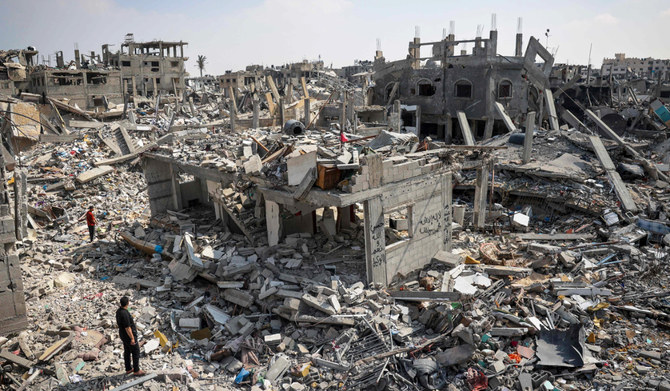
- “We do know that we estimated 37 million tonnes of debris, which is approximately 300 kg per square meter,” Lodhammar added
GENEVA: There are some 37 million tonnes of debris to clear away in Gaza once the Israeli offensive is over, a senior official with the UN Mine Action Service said on Friday.
And unexploded ordnance buried in the rubble would complicate that work, said UNMAS’ Pehr Lodhammar, who has run mine programs in countries such as Iraq.
It was impossible to say how much of the ammunition fired in Gaza remained live, said Lodhammar.
“We know that typically there is a failure rate of at least 10 percent of land service ammunition,” he told journalists in Geneva.

“We do know that we estimated 37 million tonnes of debris, which is approximately 300 kg per square meter,” he added.
He said that starting from a hypothetical number of 100 trucks would take 14 years to clear away.
Lodhammar was speaking as UNMAS launched its 2023 annual report on Friday.
The war in Gaza between Israel and Hamas erupted when Hamas launched an unprecedented attack on Israel on Oct. 7.
Also on Friday, the head of an aid group warned that an Israeli assault on southern Gaza’s Rafah area would spell disaster for civilians, not only in Gaza but across the Middle East,
Jan Egeland said the region faced a “countdown to an even bigger conflict.”
Egeland, the secretary-general of the Norwegian Refugee Council, also said that 1.3 million civilians seeking refuge in Rafah — including his aid group’s staff — were living in “indescribable fear” of an Israeli offensive.
Egeland urged Israeli Prime Minister Benjamin Netanyahu not to proceed with the operation.
“Netanyahu, stop this. It is a disaster not only for the Palestinians, it would be a disaster for Israel. You will have a stain on the Israeli conscience and history forever,” he said.
The NRC head spoke to Reuters in Lebanon, where he visited southern villages that he said were caught in a “horrific crossfire” between the Israeli military and Hezbollah.
“I am just scared that we haven’t learned from 2006,” said Egeland, referring to the month-long war between Hezbollah and Israel that was the two foes’ last bloody confrontation, during which he headed the UN’s relief operations.
“We do not need another war in the Middle East. At the moment, I’m feeling like (this is a) countdown to an even bigger conflict,” he said.
Turkiye’s Erdogan postpones tentative White House visit, sources say
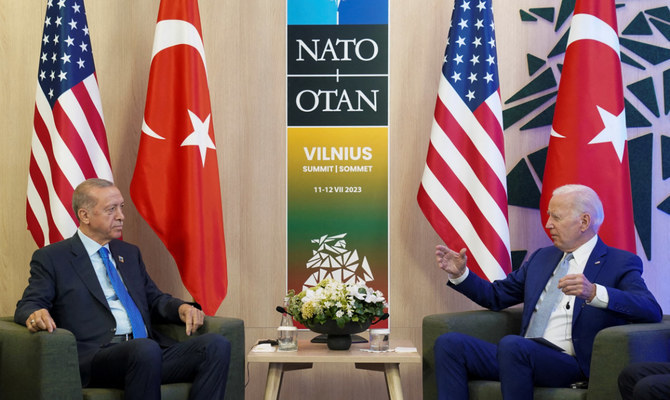
- A new date will soon be set due to a change in Erdogan’s schedule, the Turkish official said
- The source familiar with the matter, speaking on condition of anonymity, said it was unclear what prompted the postponement
WASHINGTON/ANKARA: Turkish President Tayyip Erdogan has postponed a White House meeting with President Joe Biden, a source familiar with the situation and a Turkish official said on Friday of a visit that had been tentatively planned for May 9.
A White House spokesperson, while not confirming the May 9 date, said: “We look forward to hosting President Erdogan at the White House at a mutually convenient time, but we have not been able to align our schedules and do not have any visit to announce at this time.”
A new date will soon be set due to a change in Erdogan’s schedule, the Turkish official said, requesting anonymity. The source familiar with the matter, speaking on condition of anonymity, said it was unclear what prompted the postponement.
The White House never formally announced the visit but a US official told Reuters in late March that following Turkish Foreign Minister Hakan Fidan’s visit to Washington, the White House offered and Ankara had accepted May 9 for a meeting between Biden and Erdogan.
That would have been the first bilateral visit to Washington since 2019 when Erdogan met with then President Donald Trump, a Republican. He and Biden have met a few times at international summits and spoken by phone since the Democratic US president took office in January 2021.
Ties between the US and Turkiye have been long strained by differences on a range of issues. While they have thawed since Ankara ratified Sweden’s NATO membership bid earlier this year, tensions persist over Syria and Russia and the war in Gaza.
Erdogan visited neighboring Iraq this week. Last weekend, he met with Hamas leader Ismail Haniyeh in Istanbul, the first meeting between Erdogan and a Hamas delegation headed by Haniyeh since Israel began its military offensive in the Gaza Strip following Hamas’ Oct. 7 attack.
Netherlands will consider resuming support to Palestinian UNRWA agency
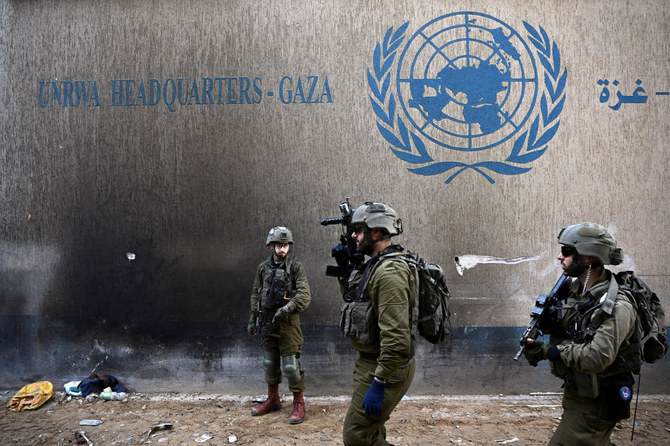
- The decision follows an investigation by the former French foreign minister Catherine Colonna
- The Colonna-led review of the agency’s neutrality concluded Israel had yet to back up its accusations
AMSTERDAM: The Dutch government on Friday said it would consider resuming funding for the UN agency for Palestinians (UNRWA) in Gaza if the agency implements recommendations to strengthen its neutrality.
The decision follows an investigation by the former French foreign minister Catherine Colonna released on Monday into whether some UNRWA employees were involved in the Oct. 7 attack by Hamas.
The Colonna-led review of the agency’s neutrality concluded Israel had yet to back up its accusations that hundreds of UNRWA staff were operatives in Gaza terrorist groups.
The Dutch government said it had already given its yearly donation to UNRWA in January, before the accusations against the agency came to light. It was one of several European countries that paused funding for the agency after the allegations were levied.
It said it did not foresee any additional donations in the near future, but would consider UNRWA as a potential partner if requests for aid were made.
150 shells hit Lebanese border towns in response to Israeli’s killing
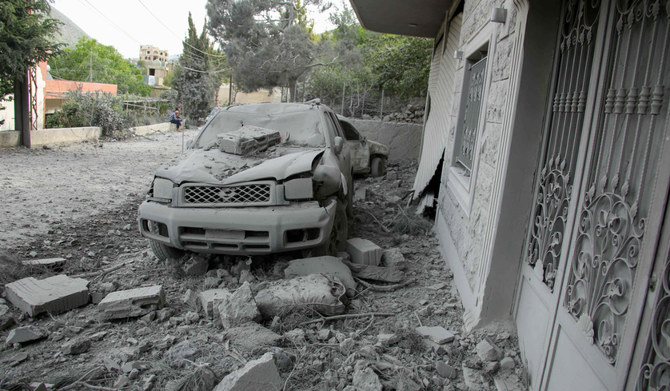
- 200 days of Israeli attacks against Lebanon have resulted in 1,359 casualties, including 344 deaths, ministry of health says
BEIRUT: The Israeli army responded on Friday to the combined operation carried out by Hezbollah in the occupied Shebaa Farms district — also known as Har Dov — with artillery shelling and airstrikes targeting the Tumat Niha area on the outskirts of Western Bekaa.
An Israeli was killed near the country’s northern border in a Hezbollah attack.
Israeli forces launched an airstrike on the outskirts of Shebaa and fired artillery shells on the outskirts of the town of Kfarchouba at dawn.
The outskirts of Shebaa, Kfarchouba and Helta were targeted with more than 150 Israeli shells.
BACKGROUND
Hezbollah has been trading almost-daily fire with the Israeli army since the day after Hamas carried out an unprecedented attack on Israel on Oct. 7.
Hezbollah members set up on Thursday night a “combined ambush of guided missiles, artillery, and rocket weapons targeting an Israeli motorized convoy near the Ruwaizat Al-Alam site, in the occupied Lebanese Kfarchouba hills.”
When the convoy arrived at the ambush point, according to Hezbollah’s statement, “it was targeted with guided weapons, artillery and rockets, destroying two vehicles.”
The party said that the Israeli army created a “smokescreen to retrieve losses.”
Hezbollah announced “targeting an Israeli force as it made it to the entrance of Al-Malikiyah site with artillery fire, and it was directly hit.”
The Israeli army confirmed the killing of a truck driver, Sharif Sawaed — a resident of Wadi Salameh — by an anti-tank shell fired by Hezbollah toward Shebaa Farms.
The Israeli army said that Sawaed was carrying out infrastructure work in the area targeted by the shell, where efforts are underway to set up a barrier on the border.
The Israeli army said that it “succeeded in retrieving the body of the dead soldier after a complex operation that lasted for hours under fire.”
The Israeli army said that warplanes later shelled Hezbollah positions in the villages of Kfarchouba and Ain Al-Tineh, a weapons depot, and a Hezbollah rocket launch pad in the Markaba area in southern Lebanon, and that two anti-tank shells were observed from Lebanese territory toward Shebaa Farms.
Israeli airstrikes led to the destruction of a house in Shebaa, two houses in Kfarchouba, and damage to more than 35 houses. One house was destroyed in Yarine, and another was destroyed in Dhayra.
Israeli artillery shelling targeted the area between the border towns of Yarine and Jebbayn.
Israeli newspaper Yedioth Ahronoth reported that the Israeli army launched an investigation into the Har Dov incident, as the engineering force was supposed to operate in the dark to avoid being targeted by Hezbollah’s missiles.
Israeli army spokesperson described what happened in the Shebaa Farms as “a difficult security incident on the Lebanese border.”
This was the first confrontation during which the Israeli army revealed details of casualties and the developments taking place at the target site.
The head of the Israeli Metula settlement council said: “It is insane how we lose houses and infrastructure every day,” adding that “Hezbollah is systematically and deliberately hurting the people of the north by doing so.”
He said that Hezbollah had “successfully deepened the security belt here after it made us flee the northern settlements.”
The Israeli army’s radio station has reported the death of 20 settlers on the Lebanese border since the start of the war more than 200 days ago.
An Israeli military drone struck a car on the Dhahira–Zalloutieh road in the border region.
The Israeli attacks against Lebanon, which have continued for 200 days, resulted in “1,359 casualties, including 344 dead people, most of whom are men,” according to a report published by the Lebanese Ministry of Health.
Israeli media outlets stated that “4,000 missiles were launched toward northern Israel from Lebanon since the beginning of the Gaza war, according to the Israeli army’s estimations.”
Hezbollah provided a detailed overview of the course of the military operations on the Lebanese southern border, stating that “it killed and wounded 2,000 Israeli soldiers, and carried out 1,650 diverse attacks, including downing five drones and targeting 67 command centers and two military factories.”
The group added that it carried out 55 aerial attacks and forced 230,000 settlers to evacuate 43 northern settlements.






